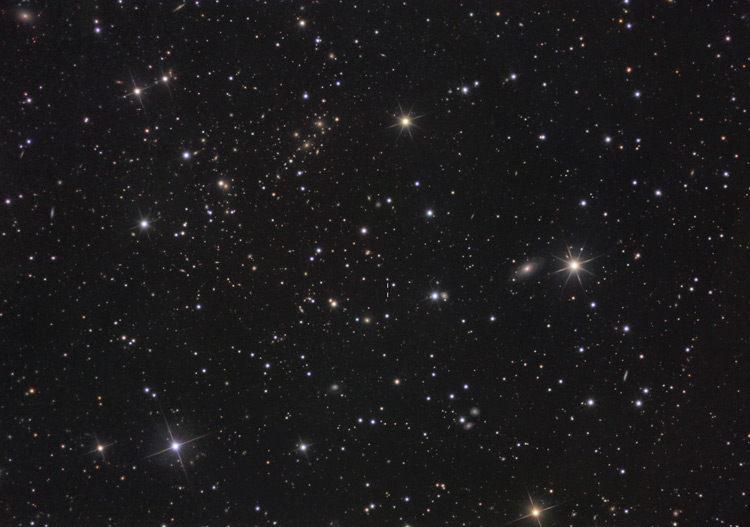
Clic here for 60% size 2249x1580 (760 kB)
Clic here for a 100% size enhanced crop 1900x151548 (809 kB)
About this Image |
|
|
Just 1.5 degree north from the bright globular M13 an elusive dim
object is embedded in a sparkling field of faint galaxies.
I recently stumbled upon a link to this publication and found it so exciting that I selected the one quasar with the best location for my site and started exposures to see what could be possible for an amateur. After having taken 4 hours of luminance there were objects up to mag 23 visible, but the quasar did not show up. Further investigation (lit. 3) showed that the emission spectrum of high redshift quasar starts above 800 nm, beyond the L band. Ken Crawford helped me out with his 20" scope and the IR sensitive KAF-6303 based camera with a clear filter. His 4.4 hours (narrower field) were combined with my own files. In the combined image the quasar shows up at exactly the predicted position, Maxim reports a visual magnitude of 24.8.
Position: RA 16:41:21.64 DEC +37:55:20.5 North is up.
Overview discovery: 1.
Discovery
publication: 2.
The redshift seven barrier:
3. Overview active
galaxies and quasars: 4. Sky & Telescope publication: 5. |
|
|
|
Optics |
16" cassegrain at f/10 |
|
Mount K. Crawford |
MK-100 GEM Paramount ME |
|
Camera K. Crawford |
SBIG STL-11000M at -15C, internal filter wheel, AO-L Trifid Gold 6303 at -15C |
| Filters | Astronomik LRGB |
| Date | June 19-25, 2007. |
|
Location K. Crawford |
Wildon/Austria Camino/CA/USA |
| Sky Conditions | mag 5 sky, raw FWHM 1.3 - 2" for L, temperature 20; |
|
Exposure JS: K. Crawford: |
L:R:G:B = 240:90:60:90 (30 min subexposures), C = 255 min (15 min subecposures) |
| Processing | Image aquisition in Maxim DL 4.56; preprocessing and deconvolution in CCDstack; other in Photoshop; |